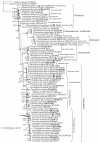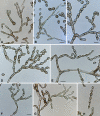Delimiting Cladosporium from morphologically similar genera
- PMID: 18490995
- PMCID: PMC2104746
- DOI: 10.3114/sim.2007.58.02
Delimiting Cladosporium from morphologically similar genera
Abstract
The genus Cladosporium is restricted to dematiaceous hyphomycetes with a coronate scar type, and Davidiella teleomorphs. In the present study numerous cladosporium-like taxa are treated, and allocated to different genera based on their morphology and DNA phylogeny derived from the LSU nrRNA gene. Several species are introduced in new genera such as Hyalodendriella, Ochrocladosporium, Rachicladosporium, Rhizocladosporium, Toxicocladosporium and Verrucocladosporium. A further new taxon is described in Devriesia (Teratosphaeriaceae). Furthermore, Cladosporium castellanii, the etiological agent of tinea nigra in humans, is confirmed as synonym of Stenella araguata, while the type species of Stenella is shown to be linked to the Teratosphaeriaceae (Capnodiales), and not the Mycosphaerellaceae as formerly presumed.
Figures












References
-
- Aptroot A (2006). Mycosphaerella and its anamorphs: 2. Conspectus of Mycosphaerella. CBS Biodiversity Series 5: 1-231.
-
- Arx JA von (1974). The Genera of Fungi Sporulating in Pure Culture. 2nd edn. J. Cramer, Vaduz.
-
- Arx JA von (1981). The Genera of Fungi Sporulating in Pure Culture. 3rd edn. J. Cramer, Vaduz.
-
- Arx JA von (1983). Mycosphaerella and its anamorphs. Proceedings of the Koninklijke Nederlandse Akademie van Wetenschappen, Ser. C, 86(1): 15-54.
LinkOut - more resources
Full Text Sources
Molecular Biology Databases
